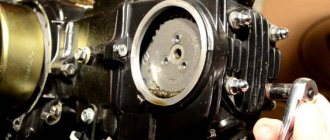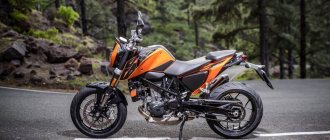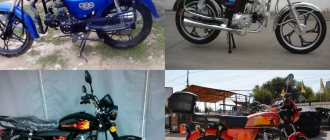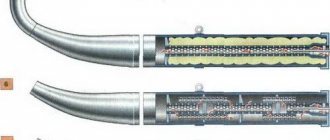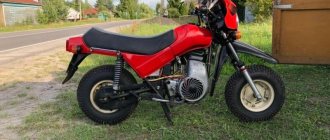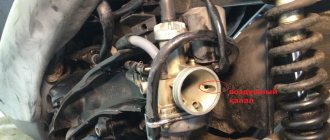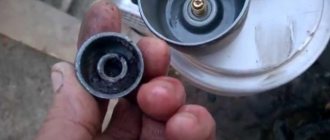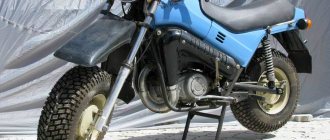Many Niva Chevrolet owners note one significant drawback of this SUV - the frankly weak technical performance of the engine. Having a considerable total weight, and considering that this is still an off-road vehicle, with a power of 80 hp. With. obviously not enough.
But this is not the final verdict for this car, because it is possible to refine the engine - tuning aimed at increasing power. Moreover, this can be done in several ways, or even use them all together to achieve maximum growth.
What has changed with the arrival of the fuel-injected Niva?
To find out which Niva is better - carburetor or injection, first you need to consider the technical characteristics of both models.
So, let's start in order. Initially, the engine for the Niva was taken from the classic Zhiguli. This is the same engine, but with an increased volume of the combustion chamber. The first for a Soviet SUV was the 2121 engine with a displacement of 1580 cubic centimeters. A few years later, the car began to be equipped with a more modernized engine. The engine received the index 21213. This is a motor with a displacement of 1690 cubic centimeters. The power of the power unit is 83 horsepower. With this internal combustion engine, the car became more playful. Acceleration to hundreds decreased to 18 seconds.
In 2005, the Volzhsky Automobile Plant switched to injection engines. This change affected all VAZ models, including the Niva. So, the car began to be equipped with an engine with the index 21214. This is a gasoline unit with a volume of 1690 cubic centimeters. The engine power remained the same as the carburetor version - 83 horsepower. Acceleration hasn't changed either. But the car’s fuel consumption has decreased by one and a half liters.
Currently, Niva cars are produced with the 21214-28 engine. These are Euro 4 engines. The working volume of the internal combustion engine is 1774 cubic centimeters. Power is 92 horsepower, acceleration to hundreds takes 17 seconds, and consumption is no more than 10 liters.
At the moment, all Nivas are produced exclusively with injection engines. VAZ engines immediately began to use distributed injection, where each cylinder had its own injector. All mechanical elements have been replaced with electronic ones. An electronic control unit also appeared in the car.
In order for the injection engine to operate stably, it required the presence of sensors for air control, throttle position, and detonation. In addition, the device now has a crankshaft position sensor.
At first glance, the system seems complicated. However, it is not. Mechanically, the engine has not become more complicated. Instead of a carburetor, injectors and a fuel rail appeared, and the throttle valve was moved separately. Only a few electronic sensors have been added, on the basis of which the electronic control unit determines the mixture and ignition timing.
How much will such a service cost from a specialist?
The price depends on whether the car owner will pick up the controller, in this case the cost will be 12,000 thousand rubles. If the controller remains with the master, then this service will cost the driver 10,000 thousand rubles. And for the Niva 21214M version the cost will be 7,000 thousand rubles. Of course, in different regions and cities, prices for chip tuning may increase or decrease, but not by much.
If you still decide to do engine tuning yourself, be sure to watch this video:
Chip tuning of a Chevrolet Niva significantly increases its capabilities, but do not forget that only a professional can perform this procedure efficiently. If you are confident in your abilities and (or) want to save a tidy sum, you can try tuning the car yourself, but the risk of serious damage rests entirely on your shoulders.
Many of those owners who drive a Niva Chevrolet note one, but quite significant drawback on this car - the rather low final engine power. Due to the fact that the car has increased cross-country ability, its weight is quite large, and 80 “stock” horses are simply not enough.
The video below will tell you about the modification of the Chevrolet Niva engine:
But, despite this, there are several ways in which you can “refresh” your car, and specifically how to do this, read below in our article.
Replacing Chevy Niva engine components
So, the first method is engine tuning, which involves replacing some components. First of all, this concerns the cylinder-piston group (CPG) and the crank mechanism (CPM), which requires boring of the liners. All this allows you to increase the working volume and, as a result, the power indicator.
First of all, boring is carried out, allowing the inner diameter of the liners to be increased. After this, a selection of pistons and piston rings of appropriate size is made. In addition, the engine is equipped with a crankshaft with elongated arms, as well as shortened connecting rods. Thanks to this, it is possible to increase the piston stroke. All this leads to an increase in volume from 1.7 liters, which the factory Chevy engine has, to 1.9 liters.
But replacing only the crankshaft and CPG motor is not enough. An increase in volume entails the need to increase the combustible mixture supplied to the cylinders and to better ventilate them. For this purpose, the cylinder head (cylinder head) is also subjected to tuning. First of all, the intake and exhaust windows are bored, and the valves are replaced with larger ones. At the same time, the valve seats are bored out and replaced.
Also interesting: Rear left wheel speed sensor (ABS) on Chevrolet Niva (VAZ 2123) | Motorring online store
Boring of inlet and outlet windows
Additionally, you can completely change the exhaust system by increasing the diameter of the exhaust pipes, and also replace the catalytic converter (catalyst) with a flame arrester.
Note that design changes to the engine will entail the need to reconfigure the operation of the fuel supply system, since with standard configurations and an increased volume, there will not be enough fuel supplied to the cylinders. That is, it will still be necessary to carry out chip tuning.
All this tuning, associated with changes in geometry, allows you to increase engine power by 15% of the nominal. But it is worth noting that an increase in volume will also entail an increase in fuel consumption.
Expert opinion
Vadim. After I moved to Niva from a foreign car, it immediately became clear that the engine would need to be completed. The lack of traction in almost any gear determines that you cannot drive comfortably off-road, and the car will not perform well on the highway. I did the tuning in stages, starting with the simplest
Egor. I decided to install a turbine on the car in question. The increase in power is quite impressive, but I decided to increase the figure by installing new sports-type consumable filters and replaced the exhaust system. I will say that the difference between 80 and 100 hp. very big.
Dmitriy. Conducted a modernization of the standard engine. I’ll say right away that no amount of tuning will solve one problem - engines of domestic origin have low reliability, you have to constantly change and finish something.
Pros and cons of the injector
Which is better - Niva carburetor or injector? Among the advantages of the carburetor Niva, it should be noted:
- Simple design of the power system. In the event of a breakdown, you can fix the problem yourself.
- Cheap service.
- Unpretentiousness to fuel quality. Many Soviet Nivas can easily “digest” even 76-octane gasoline.
- Lack of many sensors.
It would seem that the answer has been found to the question of which is better - a Niva carburetor or an injector. However, a carburetor engine has more disadvantages. Among them:
- Low reliability. Every season you need to adjust the carburetor and carry out its maintenance.
- Dependence on air temperatures. In winter, the spark plugs could easily be overfilled, making starting impossible until the spark plugs were subsequently unscrewed and dried. Also, in winter, due to condensation, the float often “stuck”. And in the summer the fuel pump often got hot.
- Greater fuel consumption.
- Less productivity. To unlock the potential of the engine, it was necessary to spin it up to high speeds.
No matter how simple and maintainable this power system may be, it requires a lot of attention. Over the course of a year of operation, you will have to rebuild the carburetor several times. A modern car enthusiast is unlikely to be happy with this situation (especially adjusting the carburetor or drying spark plugs in 20-degree frost).
Which is better - Niva carburetor or injector? This question interests many car enthusiasts. Here are the advantages of the injection Niva:
- Stable operation of the internal combustion engine. Thanks to the presence of IAC, owners have forgotten what floating speed is. For carburetor engines this was a real disease.
- Great performance. The fuel-injected Niva responds more quickly to the gas pedal.
- Less fuel consumption. We have already seen this by looking at the technical specifications. With the arrival of the injector, consumption decreased by 20 percent.
- Excellent starting in any weather. The injection engine does not flood the spark plugs, and in the summer the fuel pump does not overheat. The latter is submersible and is cooled by gasoline, as it is located in the tank.
- Reliability. Since there is no carburetor, there is no need to regularly tune it, change jets and clean it. The maximum that the owner of an injection-powered Niva can do is clean the throttle valve, but this procedure is by no means mandatory. It is recommended to do this only if the car selects high idle speeds.
Also interesting: Why does the check light on the Niva VAZ-2131 2012 light up?
What are the disadvantages of the fuel-injected Niva? There aren't many of them. Since more electronics have been added to the system, owners may experience faulty control sensors. If the car begins to consume a lot of fuel, it is worth looking at the mass air flow sensor. If the engine does not maintain normal speed at idle, the IAC may be to blame.
And if the engine refuses to start, the contact may have come loose from the crankshaft position sensor. But fortunately, these problems don't happen that often. And you can diagnose them with a simple multimeter by measuring the resistance or contact voltage of one of the sensors. Thus, breakdowns mainly concern only electronics. The mechanical part does not raise any questions.
Tuning Niva 4x4: photo and video reports of work
Turbine on a Chevrolet Niva
A turbine is one of the possible options for increasing engine power on a Niva or Niva-Chevrolet. And this option was implemented in our service. The result is on video. The turbine blows, the car drives, the client is happy.
Niva on 31 Mud-Terrain wheels
Another off-road fighter has left the Niva-Profi service center. With such modifications, you can safely take mud baths..
Niva 21214 tuning Off-road
Niva should be like this! Off-road tuning - a significant increase in off-road capabilities! Niva is pleasing to the eye..
Removable (portable) winch on Shnivy, snorkel, breathers
To overcome liquid off-road conditions, the Chevrolet Niva urgently needs a snorkel and breathers located under the hood. And the winch gives you confidence that even in the most difficult conditions you can remove the car from its mud captivity.
Another off-road fighter. Everything you need.
We pumped up the Niva. We have finalized and installed everything necessary to confidently overcome off-road conditions.
Lapter wheel arch extensions installed on Niva Urban
The difficulty of installation is that it is necessary to trim/adjust the extensions to the Urban's plastic bumper
Portable winch and off-road tuning in the field
We performed off-road preparation and installed a portable winch on the Niva
Carefully built a 12000 Lb winch into the standard Chevy Niva bumper
They hid the winch behind the standard Chevrolet Niva bumper
We installed a pneumatic block from Izh-Techno in the rear axle of a Chevrolet Niva. Watch the video.
The most effective and comfortable cross-axle differential lock is installed in the rear axle gearbox. Connects as needed from the interior with the press of one key. When driving on civilian roads it does not show itself in any way. Rating: excellent.
Beating in the brake pedal on a Niva Chevrolet. Why? Let's watch the video..
Useful video about the reason for the brake pedal beating when braking on Niva and Niva-Chevrolet
Tuning Niva, Niva Chevrolet
Many Niva and Chevrolet Niva owners sooner or later think about improving some of the qualities of their car. This could be something minor - aimed, for example, at changing the appearance (decorative thresholds, ventilation trims, spoilers, deflectors, fly swatters, etc.), or it could be something very serious related to changing the design of the car, modification transmission components, engine, suspension...
Regarding SUVs, and it is this category that the Niva and Niva Chevrolet cars belong to, questions most often arise regarding the improvement of off-road qualities. We will try to cover this topic in more detail. Everything that will be written about in this article is based solely on our experience in tuning Niva cars, and we start from the tasks that our clients set for us.
So, off-road tuning. It all starts, as usual, with something simple. You buy a car and after gaining some experience in off-road driving (fishing, hunting), you understand that if you put on mud tires, which are tougher, and even larger in diameter, then the car will drive more confidently in the mud and will drive further. And if you install self-blocks, it will be even cooler... And this process is drawn out, because every round of tuning, every new modification gives an additional advantage on the roads, and this in turn causes a feeling of deep satisfaction in Nivavod.
Leaving the lyrics aside, let's try to highlight the main approaches to modifications of Niva and Chevrolet Niva cars:
- Light. Includes: installation of high-quality engine protection and possibly gearbox; mud tires, perhaps a little larger than standard, for example 215/75 R15, but then a minimal lift will be needed; a screw self-block in the rear axle would not interfere; Well, upload another ECU firmware, because... The stock car doesn't drive very well...
- Optimal. What many clients end up with: Suspension lift of about 5 cm; cutting arches; installation of expanders; mud tires 29-30 inches; replacing the main pairs in the transmission with 4.3 or 4.44; blocking in axles, at least in the rear; power bumper + winch; snorkel; breather output; engine firmware, at a minimum, at a maximum, an increase in engine volume with accompanying modifications; It is also possible to install an expeditionary trunk with a chandelier...
- Hard. Everything that is cooler than described above: Extreme wheels from size 31 and uphill; strengthening everything that can be strengthened; clear modification of the engine; deeper modification of the transmission, etc.
It must be said that the third approach is not often chosen; as a rule, these are people keen on competitions or extreme off-road expeditions. For a fisherman, a hunter, or for weekend off-road rides, the improvements listed in the second paragraph are more than enough.
Good luck off-roading! Best regards, Niva-Profi team.
Tuning the VAZ 21213 engine
We all know very well that the Niva car is the number one SUV in Russia. Excellent cross-country ability, comfort suitable for off-road, optimal reliability and service life - a lover of hunting and fishing, a rural resident - they don’t need anything else! "TOYOTA", various "Rovers", may be something better, only their price is several times higher than even the wildest dreams and fantasies of the majority of our compatriots. And therefore, the familiar “Niva” to all of us will be our most popular car for a long time.
Tuning VAZ 21213
But now we will not talk about the most ordinary, ordinary Niva, but about a car that has undergone special training. Let's talk about the so-called “tuning” of the VAZ 21213. Every off-road driving enthusiast has repeatedly thought about how to make his “iron horse” more passable, powerful and maneuverable. It is this topic that we will now try to cover as fully as possible.
Traction balance
In order to increase the cross-country ability of the VAZ 21213, it is necessary, first of all, to improve its geometric parameters: ground clearance of the front and rear overhangs, radii of longitudinal and transverse cross-country ability. It seemed that it could be simpler - put on huge wheels and all the problems would be solved immediately. However, it later turns out that the car has become sluggish and cannot overcome the steep mountain that has long been familiar to us without prolonged acceleration. And the reason for this is a decrease in traction force on the wheels. Therefore, increasing the maximum torque of the transmission gear ratio is a way out of this situation. As it turned out, the easiest way is to modify the engine of our car. Now everyone already knows about boosting the engines of the VAZ family. The most effective and most common way of tuning a VAZ-21213 engine is to replace the existing standard “camshaft” with another one that has wider valve timing than the standard one. For off-road driving, a low camshaft is chosen, which increases torque and shifts it to the low speed zone. The most common VAZ engines are of the following volumes: 1 .6,1 .7,1 .8 liters. The 1.8L engine option is the most powerful. A car with this engine capacity is especially often used by fishermen and hunters - it simply has no equal in nature! These engine options are the most popular due to ease of repair. Further, tuning the VAZ 21213 engine is directly related to the characteristics of the route along which it is planned to travel. When driving primarily through a swamp, it is necessary to install a pipe (snorkel) that supplies air from the environment to the engine from the level of the car roof. Next, it is imperative to start sealing the ignition system of our VAZ. All toggle switches for electric radiator fans of the cooling system must be displayed on the vehicle’s instrument panel. Most often, two electric fans are installed in order to completely cover the entire radiator area and prevent the engine from boiling. The next step in upgrading the VAZ engine is to install a pump from a VAZ 2121 with an impeller that has 6 blades.
Also interesting: LADA Niva Travel – Prices and options, review, photos – – Transavto-M: LADA dealer in Prigorodny
Standardly installed radiators will serve fishermen and hunters quite well, but racing athletes try to install copper ones on their “car”, produced in the city of Orenburg, which have greater heat transfer and volume.
Drawing conclusions
When looking for an affordable off-road SUV, many pay attention to this particular offer. However, it is worth considering that the installed motor first requires repair, and then significant modernization. Lack of power off-road becomes the reason why the car cannot overcome difficult areas. There are quite a large number of ways to increase power, they all have their own specific characteristics. Here are the best slots at russvulcans-clubss.com/.
Some modifications can be done independently, others require the intervention of professionals. Note that the power increase is 20 hp. - a completely achievable task without serious intervention in the design of the motor. Of course, many improvements will require significant investments. An example is the installation of sports filters, which are much more expensive than regular filters.
Niva engine characteristics
Years of manufacture – (1994 – modern times) Cylinder block material – cast iron Power system – carburetor (21213) / injector (21214) Type – in-line Number of cylinders – 4 Valves per cylinder – 2 Piston stroke – 80mm Cylinder diameter – 82mm Compression ratio – 9 .4 Niva engine capacity 21213 – 1690 cm3. Engine power Niva 21213 – 81 hp. /5200 rpm Torque - 125 Nm / 3000 rpm Fuel - AI93 Fuel consumption - city 11.5 l. | track 8.3 l. | mixed 10.
5 l/100 km Oil consumption - 700 g per 1000 km Niva engine weight - 117 kg Overall dimensions of the Niva 21213 engine (LxWxH), mm - Oil in the Niva 21213 engine: 5W-30 5W-40 10W-40 15W-40 How much oil is in the Niva engine 21213/21214: 3.75 l. When replacing, fill in about 3.5 liters.
Niva engine life: 1. According to the plant – 80 thousand km 2. In practice – up to 150 thousand km
TUNING Potential – 200 hp. Without loss of resource - 90 hp.
The engine was installed on: VAZ 21213 “Niva”VAZ 21214 “Niva”Chevrolet Niva
Turbocharging
This method increases engine power and at the same time produces an increase in torque. It is necessary to choose a turbine carefully, since if you select it incorrectly, you may not get the desired effect. This method helps increase power by 30% while fuel consumption does not increase and to some extent even decreases.
Read news about the new field
- Do-it-yourself Niva 4x4 tuning: updating the interior of the Lada VAZ-2121
- Tuning Niva 2123
- Do-it-yourself Niva 4x4 tuning: updating the interior of the Lada VAZ-2121
- Do-it-yourself Niva tuning is accessible even to a beginner
- Tuning VAZ 2131 - tuning the interior, engine of the NIVA VAZ 2131
- Niva tuning: 145 photos of ideas on how to improve the VAZ 2121 with your own hands
- Do-it-yourself Niva 4x4 tuning: updating the interior of the Lada VAZ-2121
- Niva tuning: 145 photos of ideas on how to improve the VAZ 2121 with your own hands || Niva tuning dirt
Read news about the new field
- Niva VAZ 21213 engine: characteristics, malfunctions and tuning «
- Niva and Chevrolet Niva Tuning Shop from 10:00 to 18:00
- What you need to know about the VAZ 21214 engine before buying a Niva | Weak engine
- Niva fuel consumption. Table with fuel consumption for Niva. Acceptable fuel consumption Niva
- Engine VAZ 21213 Niva
- Engine VAZ 21213 Niva
- The best automatic transmissions and engines for the VAZ 2121 Niva, characteristics, gasoline, diesel internal combustion engines
- Engine VAZ 21213 Niva
Optics
The optics are worth special attention, and you can transform your headlights thanks to the special glow. Get GT Block Small reflectors and Hiper Flux yellow LED chips. Additionally, you will need black spray paint.
The procedure will be as follows:
You can use other options for localizing holes - it all depends on your imagination. LED strip can replace single diodes, so you will save time and effort.
Such tuning of a Chevrolet Niva with your own hands will allow you to save on energy consumption, extend the service life of lighting elements and increase brightness.
Results
In conclusion, I would like to note the fact that the optimal way to increase engine power is to use several methods, such as replacing engine parts with chip tuning, or installing a turbine with chip tuning.
However, if you plan to use such a car in most cases in mud and on rough roads, then changing just one engine will not be enough. Changes will have to be made to the suspension system, wheels and transmission.
Source
Reprogramming the electronic control unit
The most common method of engine modification is chip tuning. The undoubted advantage of this method is that it does not require significant capital investments, but at the same time it is quite effective. This is due to the fact that chip tuning does not provide for design modernization of the engine.
The essence of chip tuning lies in making changes to the existing ECU system, adjusting the entire fuel supply complex. By changing the properties of the power unit, you can achieve both a reduction in fuel consumption and an increase in power. But at the same time, it is possible to install such software in which a balance will be maintained between consumption and engine operation.
As practice shows, standard chipping can increase power by 15%. But do not forget that these operations will lead to an increase in the load on various components of the motor, which will affect its service life.
With proper work with the software, you can achieve successful optimization of engine operation, namely setting it to 110-120 hp. at the same fuel consumption.
The modernized engine received the index 2123, it was changed only because of the engine compartment, but everything remained from the old engine and is easily interchangeable with 21214. Its production began in 1994, the block is made of cast iron. The head has two valves per cylinder, the pistons were installed with a diameter of 82 mm, and their stroke remained the same and equal to 80 mm. The increased diameter of the piston made it possible to increase, albeit slightly, its power; it became equal to 81 hp, with a compression ratio of approximately 9.4.
When operating at a speed of approximately 3,000 per minute, the maximum possible torque of 125 NxM is obtained. The fuel recommended by the plant is AI 93 gasoline, but its appetite is somewhat voracious, ranging from 10 to 12 liters per 100 km. mileage Its mass is 117 kg. The design provides for an overhead camshaft and a timing chain drive.
In the new Niva, they changed the method of installing the unit in the engine compartment, as well as the location and fastening of attachments. As an advantage, we can note the installation of hydraulic compensators for valves and a chain tensioner. Disadvantages include noise and slight vibration of the engine. Manufacturers claim its resource is approximately 80,000 km. mileage, but practically it is much higher and can reach up to 200 thousand.
Weaknesses of the ZMZ 409 engine
List of disadvantages of all modifications of ZMZ 409:
- The engine often stalls;
- It makes noise, vibrates;
- Maslozhor;
- The engine knocks;
- The motor is tripping;
- Prone to overheating;
- Low quality of parts and components;
- High fuel consumption;
- Expensive to maintain and repair.
Read more about the disadvantages of the ZMZ 409 power unit
It often stalls. The problem is a sign of failure of the spark plug armor wires, crankshaft sensor and IAC.
It makes noise and vibrates. The reason is the wear of the hydraulic chain tensioner.
Overheats. Obvious reasons: the thermostat is not working; the problem is in the radiator; The system is leaking; antifreeze does not circulate due to air locks. There are dips in traction and the revs are floating at XX. Conduct diagnostics on the ignition coils; as a rule, they are the ones that fail.
Maslozhor. Oil consumption depends on the condition of the valve stem seals and piston rings, however, as their degree of wear increases, oil consumption increases. Check their condition.
The engine knocks. To fix the problem, the hydraulic compensators must be replaced. These consumables last no more than 50,000 km.
Troit. To identify the cause of the defect, it is necessary to check the serviceability of the ignition coils and spark plugs, measuring the compression in each cylinder.
There is a predisposition to overheating. The design predisposition to high temperatures requires maintaining high speeds corresponding to the selected gear. When working on site in the hot season (in traffic jams), you have to turn on the interior heater radiator to reset the temperature. Malfunctions of cooling system components (leaks, radiator, thermostat, fan) can increase the risk of engine overheating.
PS. Dear drivers who spend time behind the wheel of the corresponding UAZ vehicles! I look forward to your feedback and comments on the weak points and shortcomings of the motor.
One significant drawback of the Chevrolet Niva SUV, as many car owners believe, is its weak engine. Considering that this is an SUV and its weight is not small, the power of 80 hp is still not enough for it.
To correct this drawback and increase the power of the Chevrolet Niva engine, modification is necessary; it can be done using several methods, using tuning, due to which the engine will receive the maximum possible increase in power.
Many Niva Chevrolet owners note one significant drawback of this SUV - the frankly weak technical performance of the engine. Having a considerable total weight, and considering that this is still an off-road vehicle, with a power of 80 hp. With. obviously not enough.
But this is not the final verdict for this car, because it is possible to refine the engine - tuning aimed at increasing power. Moreover, this can be done in several ways, or even use them all together to achieve maximum growth.
Geometry improvement work
Due to the low engine efficiency and low wear resistance, mechanical tuning of the Niva 4x4 engine is almost mandatory. Such work is called work to change the geometry of the power plant. You should start modifying the power plant by upgrading the carburetor. We do the following:
- We change jets with an indicator of 1 kam to a jet with an indicator of 2 kam;
- Renewing the accelerator pump nozzle.
If there is dirt or carbon deposits in the carburetor, we clean it manually. To do this we need a rag, gasoline and physical strength. If the dirt is very stubborn, a high-pressure cleaner or other device designed for washing the car will help. You can also use special “baths” to remove dried dirt from parts. In this way, the fuel supply to the gas distribution mechanism can be significantly improved.
If you are the owner of an injection Niva, then independently modifying the injector is unacceptable. Only a professional with knowledge of software can perform such tuning of the Niva engine.
